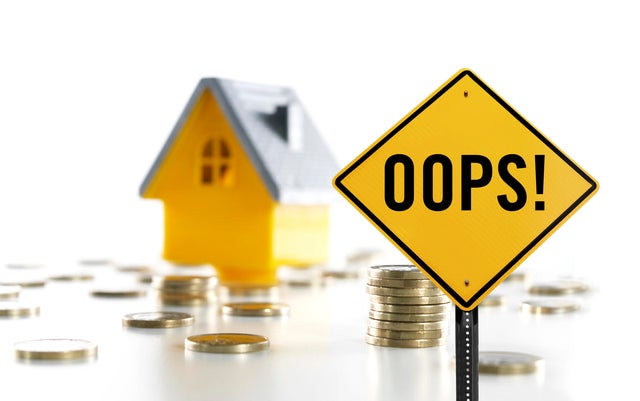3 expensive home equity borrowing mistakes to avoid this August
With inflation still lingering and interest rates holding firm, many homeowners are turning to their biggest asset — their homes — to fund everything from renovations to credit card consolidation. Thanks to rising property values over the last few years, homeowners have more tappable equity than ever before, with the average owner having about $313,000 in equity currently. And, borrowing against your home equity can offer a lower-cost option, too, as rates on both home equity loans and home equity lines of credit (HELOCs) are currently much lower than rates on credit cards or personal loans.
But when it comes to tapping into your home equity, the timing matters — and so does the strategy. Home equity loans and HELOCs may be more affordable overall than the alternatives, but making the wrong move in today's environment could still cost you more than expected. And, as the Fed continues its wait-and-see approach on rate cuts, borrowers need to be extra cautious about how — and when — they tap into their home's value.
So, if you're considering borrowing against your equity this August, it could pay to plan carefully and fully understand the potential pitfalls that can derail your borrowing strategy.
Compare your home equity borrowing options to find the right fit today.
3 costly home equity borrowing mistakes to avoid this August
As you tap into your home's equity this August, make sure you avoid these potentially costly mistakes:
Opting for a HELOC when you need predictable payments
A HELOC gives you access to a line of credit that's tied to your home's equity, and it can be borrowed from (and repaid) as necessary throughout the draw period. As a result, it can be a flexible option, especially if you don't need all the funds at once or want to borrow on an as-needed basis. But here's the catch: HELOCs typically come with variable interest rates. That means your rate (and your monthly payment) can climb over time, which could get expensive if the Fed decides to raise rates again later this year or even hold them higher for longer.
While some economists expect rates to stay steady or drop through the end of 2025, it's always possible that future inflationary surprises could push the Fed to take action. If that happens, borrowers with variable-rate HELOCs could see their interest charges inch up, potentially adding hundreds of dollars to their monthly costs by this time next year.
That doesn't mean a HELOC is a bad idea right now. Rates on these borrowing options can also drop as the rate environment eases, so the variable nature of the rate can be a good thing, too. But if you need predictability in your budget or believe rates could go higher, a fixed-rate home equity loan may be the safer bet. You'll lock in a consistent rate and payment from the start, which can help protect your finances in a volatile rate environment.
Learn how affordable the right home equity borrowing options could be now.
Borrowing more than you really need
Home equity borrowing can be tempting, especially when lenders dangle large credit limits based on your home's value. But just because you can borrow a large amount doesn't mean you should. In today's economic climate, overborrowing can quickly backfire, especially if your income changes or home values decline.
Lenders may allow you to borrow up to 85% of your home's appraised value (minus what you owe on your mortgage), but stretching yourself to the max can be risky. Not only will you pay more in interest over time, but your monthly payments may become unaffordable if rates increase (in the case of HELOCs) or if your financial situation shifts.
So, take a hard look at your actual financial need and borrow only what's necessary. Whether you're remodeling your kitchen or consolidating debt, build in a cushion, but don't max out your available equity. Keeping your loan amount modest gives you more flexibility if market conditions change down the road.
Ignoring closing costs and hidden fees
While home equity loans and HELOCs typically offer lower interest rates than personal loans or credit cards, they're not fee-free. Many lenders charge closing costs, application fees, appraisal costs, annual fees and even early termination penalties. And in some cases, those costs can eat into your loan's value, especially if you're borrowing a smaller amount or planning to pay it off quickly.
Some lenders also offer "no closing cost" home equity loans or HELOCs, but those offers often come with a tradeoff in the form of higher interest rates or built-in fees elsewhere. And, if you don't read the fine print or compare multiple loan offers, you could wind up paying far more than expected.
That's why you should be sure to always ask lenders for a full breakdown of fees and compare the APR (and not just the interest rate) between offers. The APR includes both the rate and associated costs, giving you a clearer picture of what you'll actually pay. If you're not sure how long you'll keep the loan, pay close attention to any prepayment penalties, too.
The bottom line
Home equity loans and HELOCs can be powerful financial tools, but only when used wisely. In an uncertain rate and economic environment, like the one we're seeing now, borrowing mistakes can be especially costly. But by choosing the right loan structure, borrowing only what you need and understanding the full cost of the loan, you can make the most of your home's value without putting your financial future at risk.
